All Japanese maples are gorgeous, but let’s be honest – it’s the red ones that really stand out in the garden.

We link to vendors to help you find relevant products. If you buy from one of our links, we may earn a commission.
Those scarlet leaves are like little flags, demanding your attention. Their hue also makes the lobes and serrated margins all the more obvious, adding to their appeal.
Not sure how to choose?
Whether you’re looking for disease resistance, a particularly nice shape, exceptionally vibrant color, or a combination of all three, the red options in this roundup are the best of the best.
Here’s a quick preview of the varieties we’ll discuss:
11 Favorite Red Japanese Maples
If you’re looking for a superstar red Japanese maple for your garden, one of these is sure to be a winner.
1. Bloodgood
‘Bloodgood’ was bred at Bloodgood Nursery in New York, named for a family of growers rather than its blood-red leaves.

But this moniker is in no way misleading for those who don’t know the history behind it, because the finely serrated leaves are a marvelous bright scarlet in the spring before shifting to maroon in the summer and back to bright red in the fall.
This upright A. palmatum grows to a mature height of 25 feet over the course of about 30 years.
Head to Nature Hills Nursery to bring home a two- to three-foot tree in a #2 container.
2. Crimson Queen
‘Crimson Queen’ reigns over the Japanese maple world with her standout cut-leaf foliage. Each leaf is deeply lobed with serrated edges, and looks like bright vermillion lace.
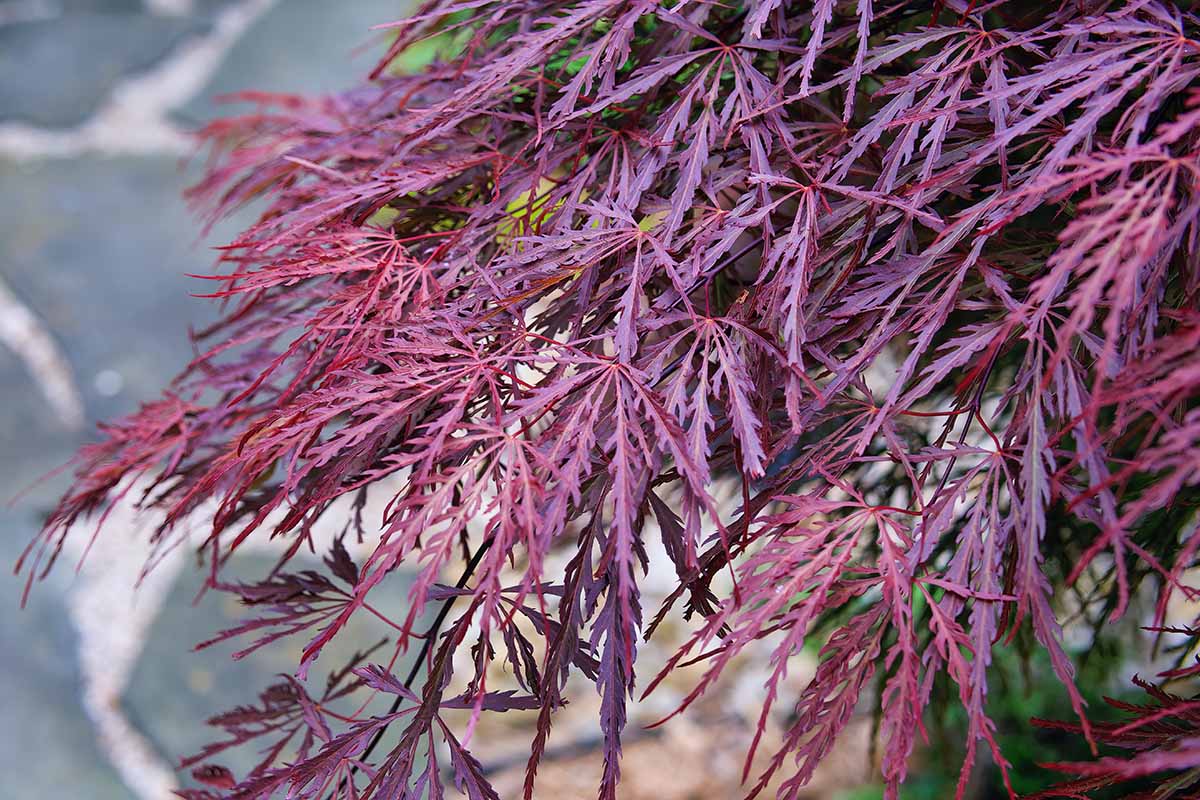
But the Queen doesn’t need to be large to reign mightily.
She’ll reach about five feet in roughly 15 years, with a gracefully weeping growth habit. If you’re patient, she’ll continue to grow to about 10 feet tall and wide in ideal conditions.
This regal ruler’s cloak retains a deep crimson from spring through fall, with deeper coloring in partial shade.
Welcome royalty to your garden by purchasing a one- to two- or two- three-foot plant at Planting Tree.
Learn more about growing ‘Crimson Queen’ trees.
3. Emperor One
Whether you call this majestic tree Red Emperor, Emperor I (aka Emperor One), or A. palmatum ‘Wolff,’ this cultivar is one of the most popular and beloved Japanese maples.
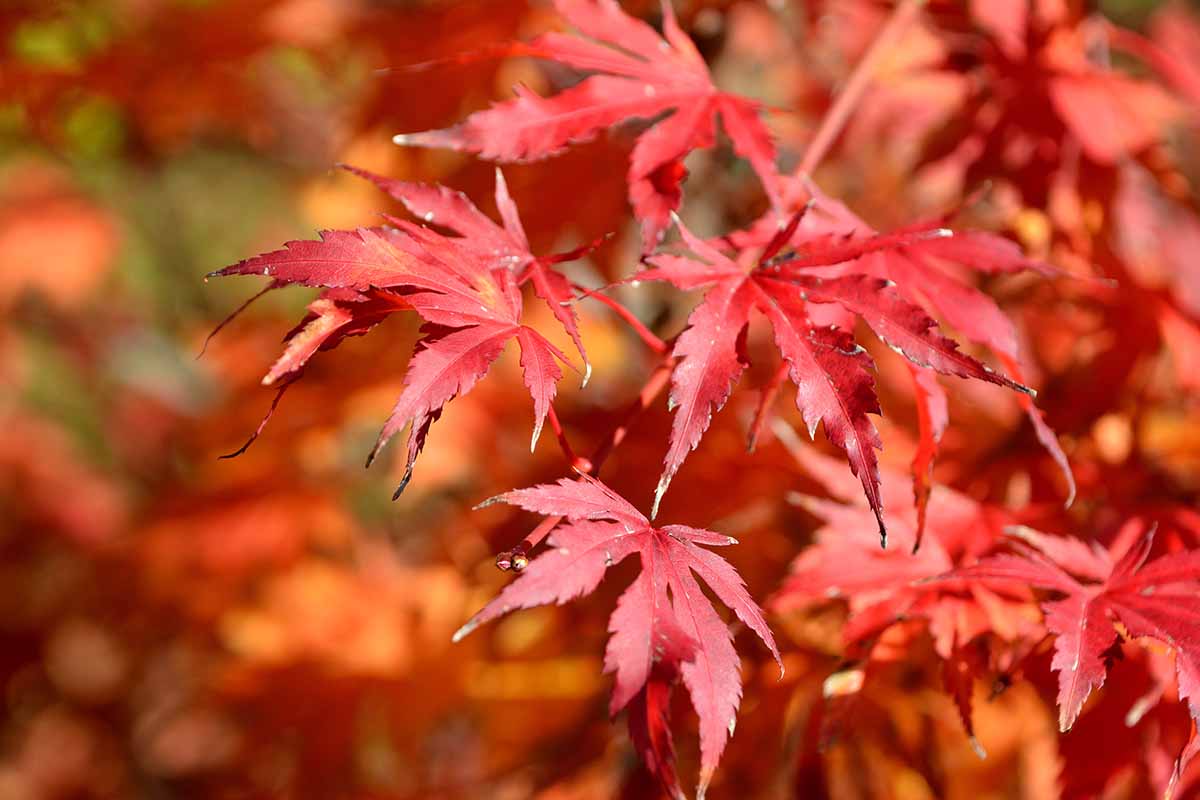
In the spring, this leader among maples wears a crimson cloak that shifts to maroon all summer before swapping out his raiment for something scarlet.
But there’s a surprise underneath. When the wind blows, the underside of each leaf is olive green. It makes for a beautiful contrast.
Because the Emperor leafs out a bit later in the spring than some types, you rarely have to worry about frost damage.
He’s also heat and cold tolerant, and moderately slow growing – expect a height and spread of about 15 feet at maturity. Plus, this variety is extremely resistant to pests and diseases.
Nature Hills Nursery carries this perennial favorite. Two- to three-foot tall plants are available in #2 containers.
4. Fireglow
Warn the neighbors when you plant ‘Fireglow’ because they might want to call the fire department when they see the sun shining through the vibrant leaves of this tree, which sets the landscape ablaze with a glowing three-season display.
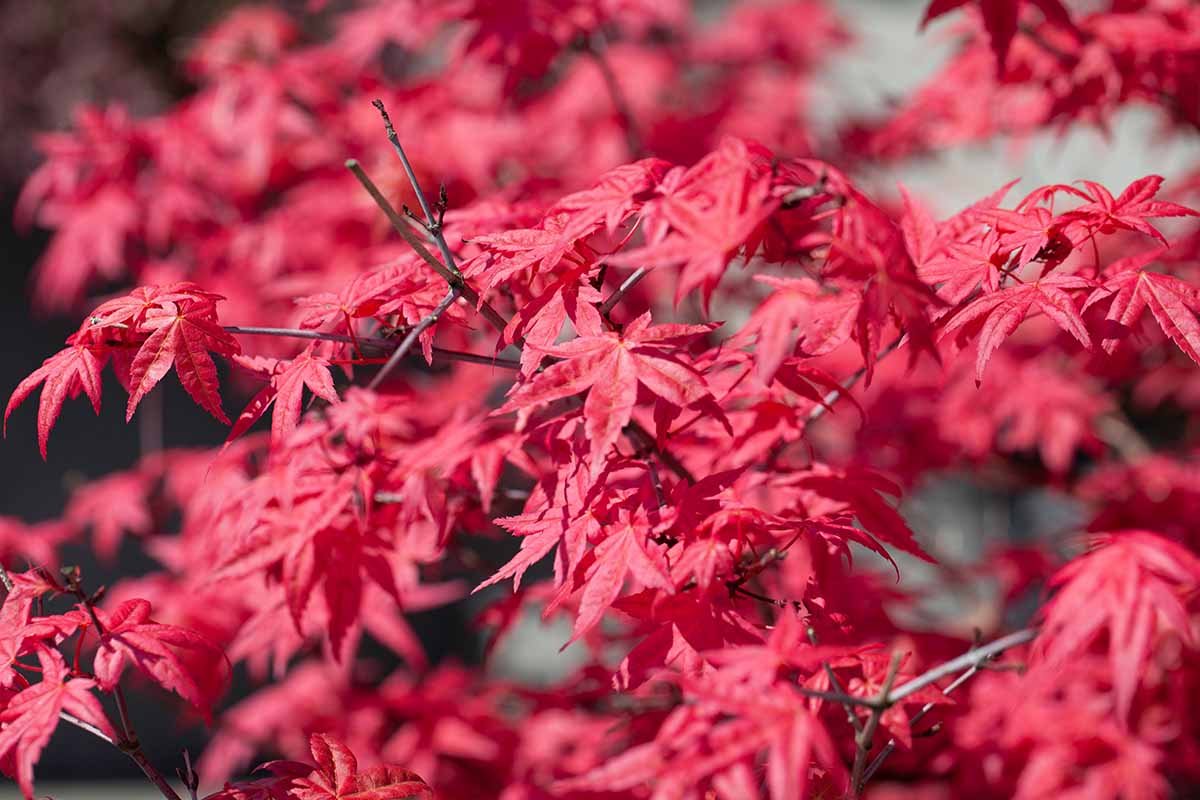
In the spring, the leaves emerge with a striking, bold, and bright ruby color.
These transition to maroon in the summer, though they’ll develop an orange hue on the back in direct sun. Come autumn they’ll change again, this time to a fiery red with hints of orange.
The heavily lobed, palmate leaves may look delicate, but ‘Fireglow’ is known for being tough enough to withstand direct sun even in hot climates.
It won’t outgrow a small space either, topping out at about 10 feet in 15 years.
Light up your landscape by picking up a tree from Maple Ridge Nursery.
5. Garnet
‘Garnet’ is a weeping ruby-colored A. palmatum var. dissectum – aka weeping Japanese maple – that lives up to its name.
It starts the season with deep maroon foliage before gradually transitioning to bright, deep garnet in the fall. It stays extremely compact at five feet tall and wide, with a natural umbrella-like form.
The deeply-lobed leaves are heavily serrated, giving the impression of a bunch of jewel-like strips of lace dancing in the wind.
If this gem’s got your eye, plants are available from Nature Hills.
6. Oregon Sunset
Like the changing colors in the sky just before dusk, A. palmatum ‘Oregon Sunset’ gradually transitions through various colors through the growing season.
The rounded, palmate leaves start out bright red before changing to plum purple in the summer. When fall arrives, they shift to orange-red.
This slow grower is perfect in containers or a small garden plot. It only reaches seven feet tall in 20 years, but will eventually reach 10 feet tall and wide in ideal conditions with time.
If you live somewhere with hot summers, plan to give this cultivar a little protection from the afternoon heat.
If you’re ready to sit back and enjoy a three-season sunset in your garden, grab a two- to three-foot potted specimen at Planting Tree.
7. Pévé Starfish
If you want something a little different to stand out from the laceleafs and the typical palmates of the Japanese maple world, check out ‘Pévé Starfish.’
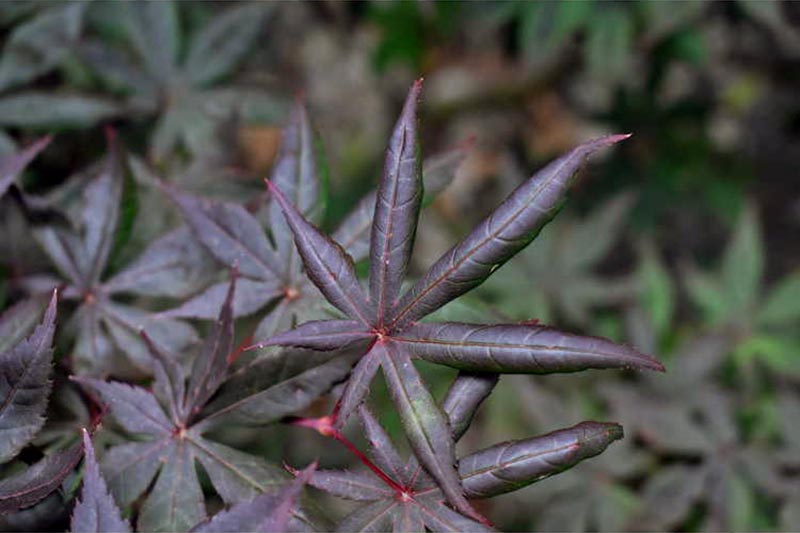
Well-known Dutch breeder Piet Vergeldt introduced this unusual A. palmatum, which has backward-cupped leaves that distinctly resemble red starfish.
The foliage is bright crimson in the spring, maroon in the summer, and even brighter crimson in the fall, and trees stay under eight feet tall.
Pick up ‘Pévé Starfish’ in one- and three-gallon containers from Maple Ridge Nursery.
8. Red Dragon
A. palmatum var. dissectum ‘Red Dragon’ is an elegant weeping tree that stays small, reaching just four feet in height in about 10 years.

But while its fernlike, thin, heavily serrated, scarlet leaves are gorgeous, what makes this tree so highly sought after is its ability to hold its color all summer – even when it’s extremely hot and other maples are fading.
‘Red Dragon’ doesn’t need the heat to look its best, though. It will retain its crimson hue even in partial shade.
Ready to pick up a dragon of your very own to tame at home? Planting Tree has specimens available in one- to two- or two- to three-foot heights.
9. Red Select
They emerge deep purple in the spring, but by fall the leaves turn a bold, vibrant red.
Combined with a gracefully arching growth habit, ‘Red Select’ makes for an elegant centerpiece or accent in your outdoor space.
This plant was cultivated from the ever-popular ‘Inaba Shidare’ and they look fairly similar, though ‘Red Select’ features smaller leaves. It reaches 10 feet tall and 15 feet wide at maturity.
Some Acer plants are sensitive to pollution, but not ‘Red Select.’
This A. palmatum var. dissectum cultivar has palm-shaped leaves and the young branches are red, gradually fading to gray as they mature.
Ready to select this beaut for your garden? Nab one at Fast Growing Trees. They carry this classic option in a one- to two-foot height.
10. Tamukeyama
Chances are there’s a ‘Tamukeyama’ growing in a garden near you. That’s because it’s been available to gardeners for over 300 years and it ticks all the right boxes.

It’s a vigorous grower, tolerant of heat, leafs out later in the spring to avoid late frost damage, and it holds its color well all summer long.
The cascading, umbrella-like shape requires little pruning to maintain, and the deeply lobed, heavily serrated leaves look like petite crimson ferns.
The color starts out plum and stays that way throughout the summer before shifting to vibrant crimson in the fall.
It grows up to 10 feet tall and 12 feet wide.
Nature Hills Nursery carries this classic in #2 nursery pots, or in #10 containers so you can get a jump on the growing process.
11. Twombly’s Red Sentinel
Ken Twombly of Twombly’s Nursery in Connecticut spotted an unusual growth on a Japanese maple at a church one day.
Recognizing a good thing when he saw it, he propagated the cutting and the result is a stunner that is unparalleled in the Japanese maple world.
This tree is upright and extremely narrow with a three-foot width and a 10-foot height when mature. Position these in a row or as a single bright scarlet sentry in the garden.
The leaves are palmate with seven lobes that feature finely serrated edges. Purplish-red during the summer, they brighten up to a bold, bright vermillion in the fall.
You can find ’Twombly’s Red Sentinel’ available from Maple Ridge Nursery in one-, three-, and seven-gallon containers.
Red Means… Go!
When it comes to Japanese maples, red means go! Pop on over to your nearest nursery either online or in person, and scoop one up to add bold, bright color to your outdoor space.
And if you need to brush up on how to care for these trees, check out our growing guide.
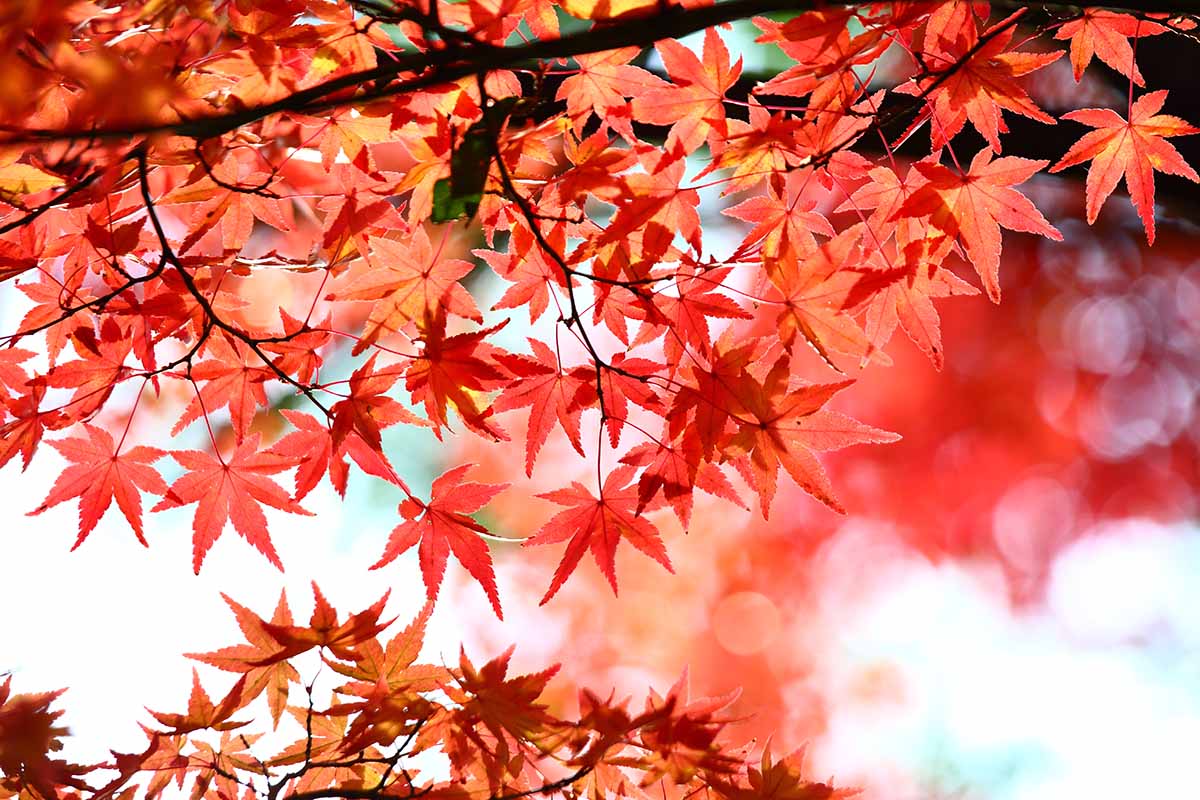
Which one will you pick? Or did we miss one that you’re particularly fond of? Share with us in the comments!
Of course, there’s more to these marvelous trees than what we’ve covered here. If you found this article useful, read these Japanese maple guides next:
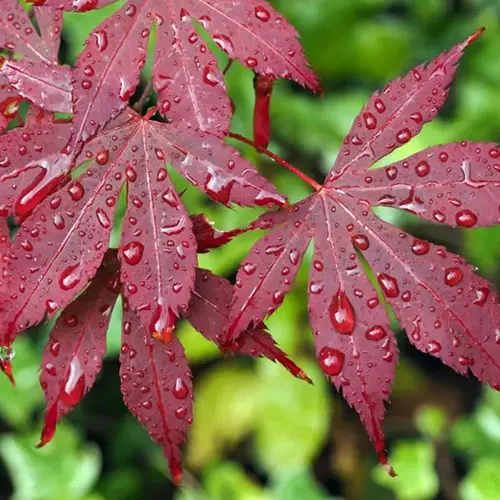
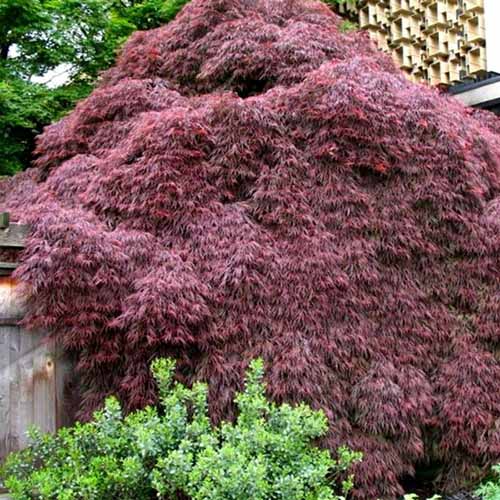
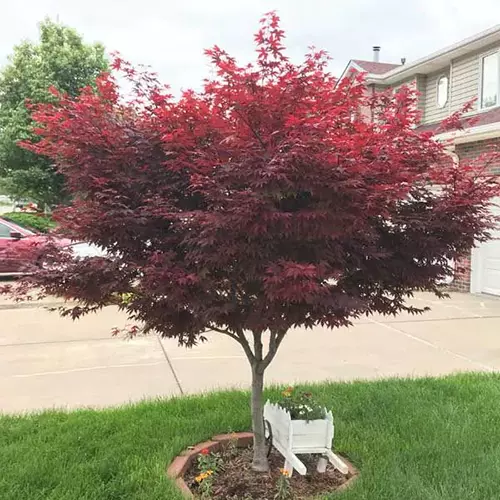
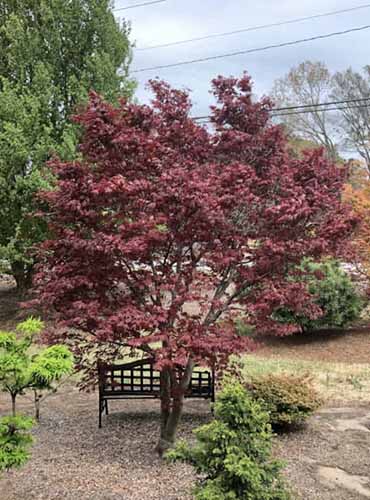
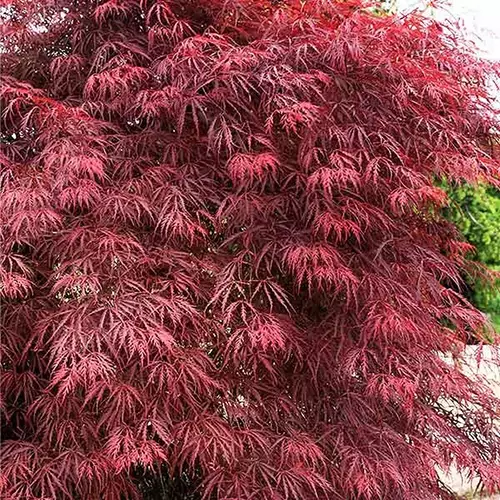

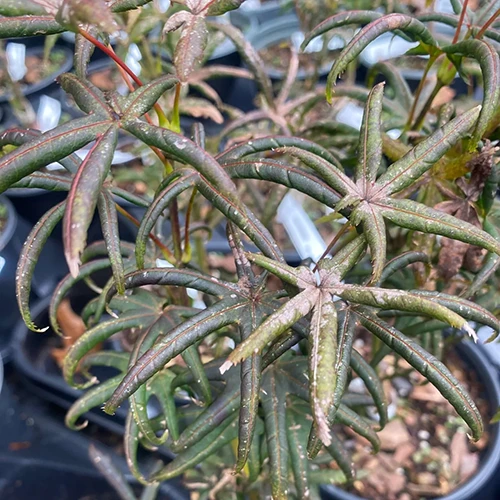
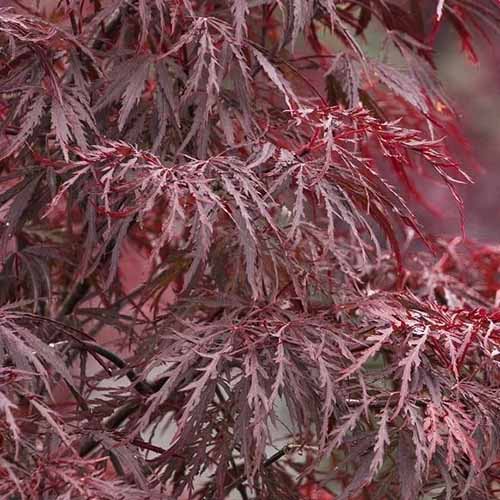
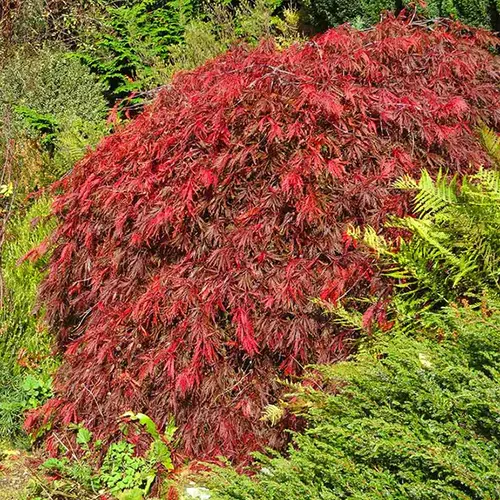
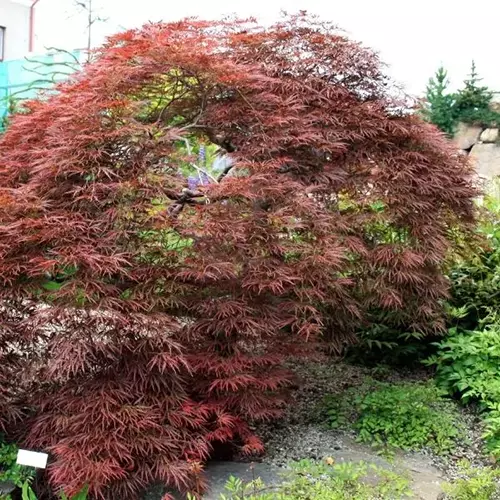
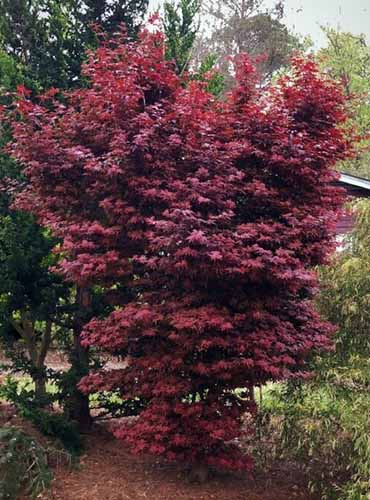
Hello Kristine Lofgren, I appreciate the valuable information you’ve shared. I reside in Kentucky and have recently acquired a Red Japanese Maple (Acer palmatum var. atropurpureum). My intention was to cultivate a dwarf variety in proximity to my house, roughly 5 feet from the exterior wall. However, upon thorough reading, it became evident that the plant I’ve acquired is not a dwarf variety. Could you please provide guidance on whether it’s suitable to grow this tree near my house without causing harm to the foundation or any other structural elements? Additionally, I’m curious if it’s possible to prune or trim… Read more »
Hi, I’m so glad our guide was helpful. Japanese maples aren’t particularly aggressive and aren’t known to damage home foundations, but a full-sized tree shouldn’t be planted within five feet of your house. It can trap moisture and create a home for pests in your home’s walls. The roots might also poke into any existing cracks in the foundation. It can also hurt the tree by reducing air circulation. You won’t be able to keep the tree in a dwarf size unless you plant it in a container and regularly prune the roots. It’s probably best to find a dwarf… Read more »